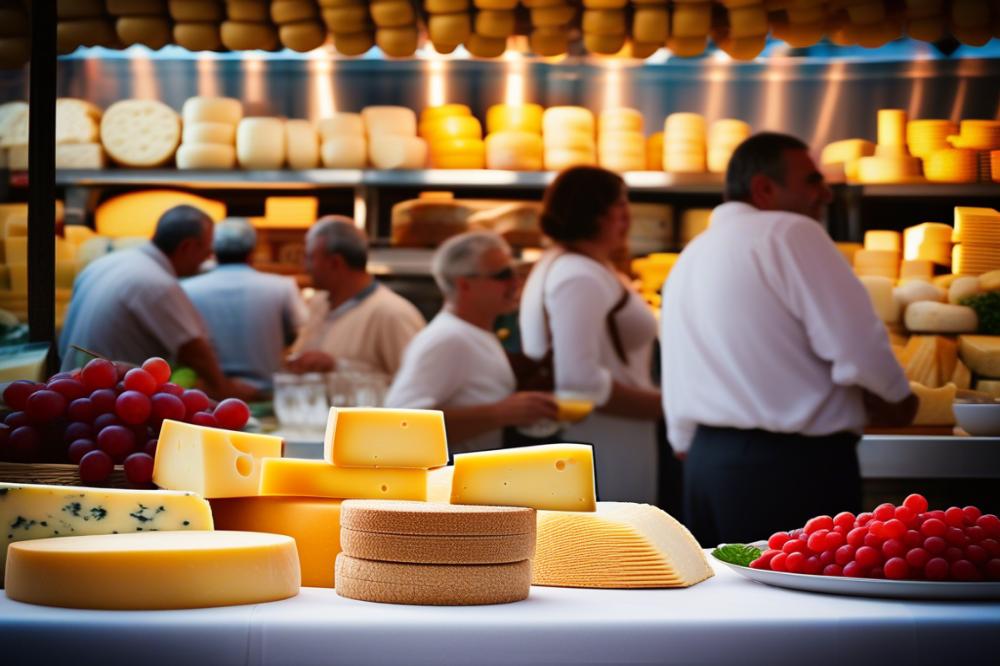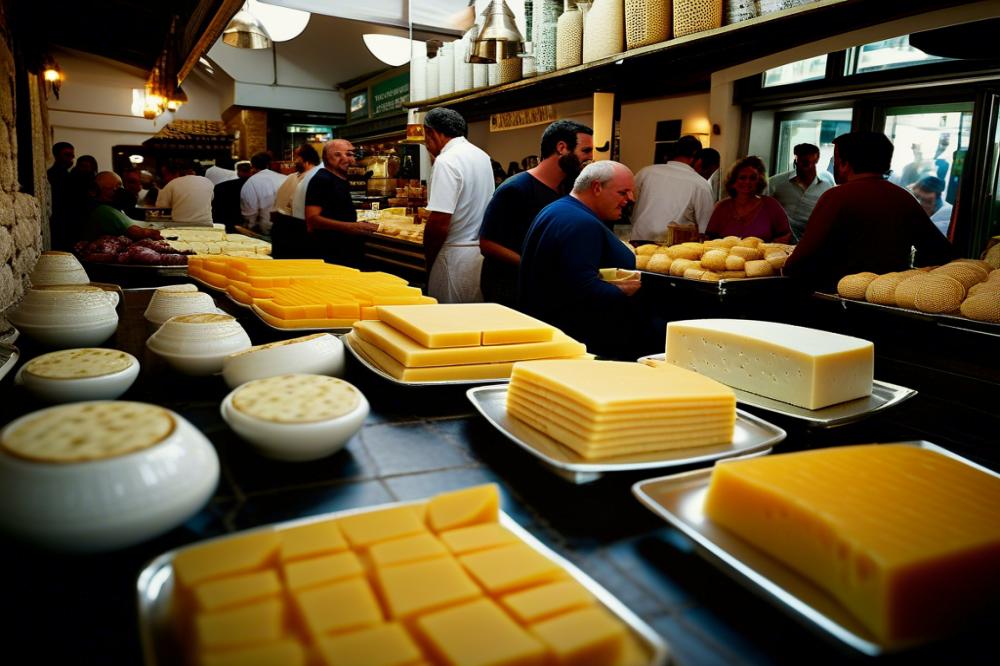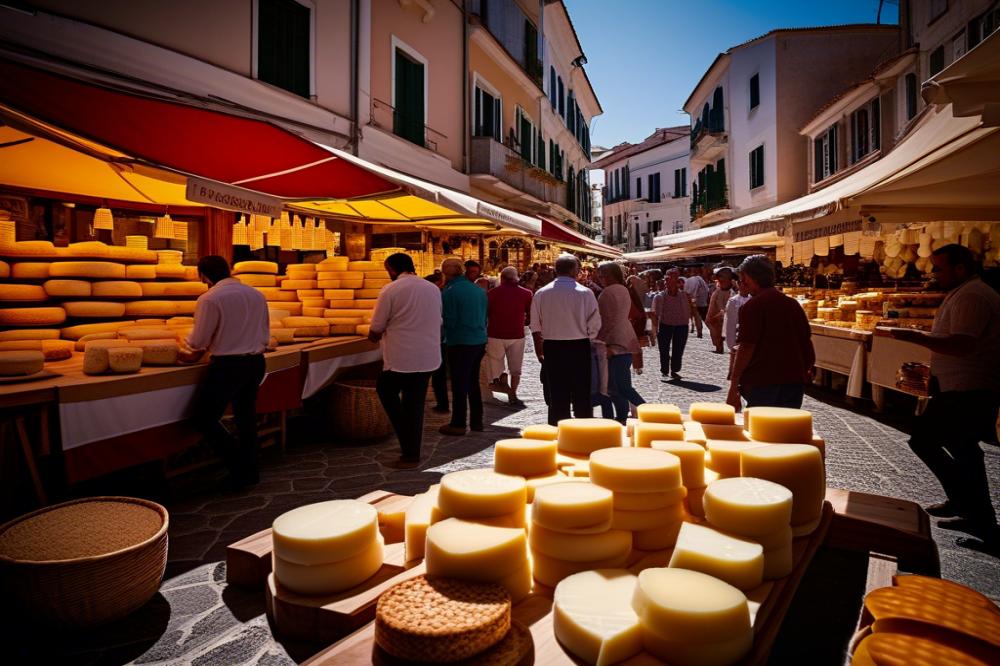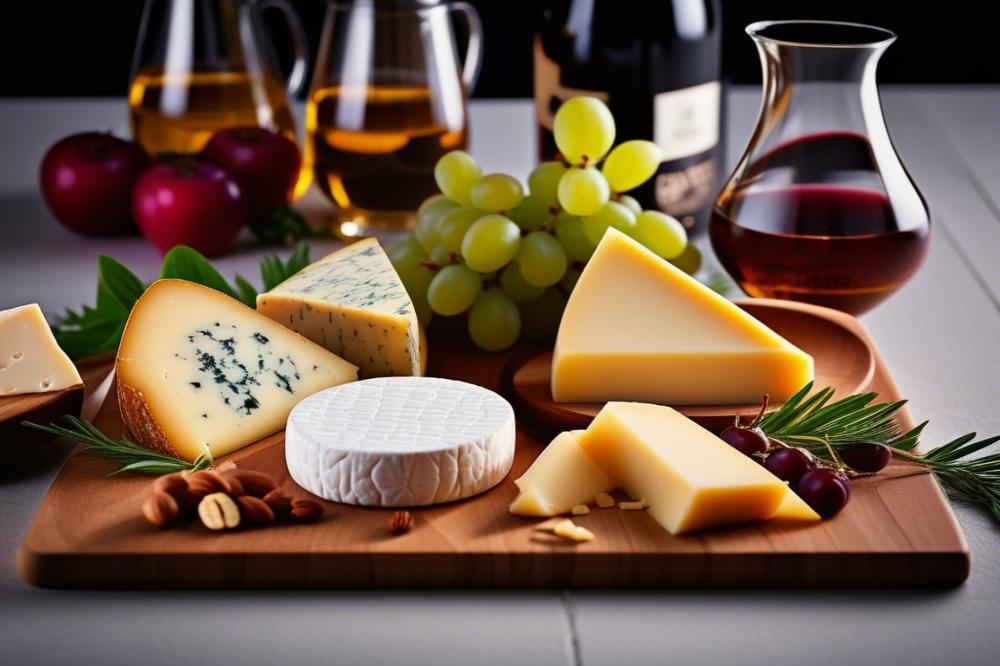Culinary Adventures in Greece
Exploring Greece through its flavors offers an exciting journey. Many travelers delight in the country’s rich culinary travel adventures. The diverse landscapes, vibrant markets, and warm locals all add to this experience. One of the highlights is discovering local cheeses that are essential to Mediterranean cuisine.
Greek cheese holds a special place in the hearts of many. Among these artisan cheeses, Graviera cheese stands out as a popular choice. Its complex flavor notes and versatile cheese profile make it a staple in Greek cuisine. Visitors often find that cheese tasting becomes an essential part of their culinary explorations.
Sampling local cheeses allows people to engage with the culture. Each cheese variety tells a story of tradition and regional ingredients. The taste of Graviera, with its rich and slightly nutty character, introduces travelers to local flavors. Then there’s Kasseri cheese, known for its smooth texture and tangy bite. Together, these cheeses exemplify the best of Greece’s cheese culture.
Cheese pairing is favored among enthusiasts. Enjoying these flavors with olives and fresh bread enhances the tasting experience. This article will focus on how to truly appreciate these local cheeses. Join us as we uncover the delights of sampling Graviera and Kasseri, and celebrate the vibrant cheese scene in Greece.
Understanding Graviera cheese

Graviera is among the most renowned Greek cheeses, holding a special place in the hearts of many. Its origins trace back centuries, specifically associated with regions like Crete and Naxos. The traditional version from Crete boasts a Protected Designation of Origin status, meaning it can only be produced in that specific area, maintaining age-old methods and local ingredients.
Various varieties of this cheese exist across different regions. Cretan Graviera, made from sheep’s milk or a mix of sheep’s and goat’s milk, is celebrated for its rich yet mild flavor. In contrast, the variety from Naxos tends to be creamier and has a hint of sweetness due to a higher cow’s milk content. Each of these local cheeses reflects the unique terroir of its region.
When tasting Graviera, one can expect a wonderful array of flavor notes. It often presents nutty undertones, accompanied by hints of sweetness and a somewhat buttery finish. The texture is firm yet smooth, making it ideal for slicing. Many enjoy it paired with fruits, nuts, or drizzled with honey during cheese tasting sessions.
In Mediterranean cuisine, this cheese shines in various dishes. It can be grated on pasta or melted in pies, adding depth to savory recipes. Additionally, it works well in cheese pairings, complementing both red and white wines. Cheese profiles that include Graviera often highlight its versatility and enduring appeal within Greek cheese culture. Whether enjoyed simply or as part of a more complex dish, it continues to captivate hearts and palates alike.
Kasseri: A Companion Cheese

Kasseri cheese is a beloved staple of Greek cheese culture. This semi-hard cheese is known for its smooth texture and delightful flavor. Made primarily from sheep’s milk, it carries a mild, slightly tangy taste. The cheese is often enjoyed in different settings, from casual gatherings to special feasts.
When comparing Kasseri to Graviera, notable differences emerge. Graviera is usually more robust and nutty in flavor. It undergoes longer aging processes, which enhances its complexity. Kasseri, on the other hand, is aged for a shorter time. This results in a texture that is more tender and creamy. Its flavor notes are fresh and slightly sweet, making it an excellent partner for other local cheeses.
Each cheese variety has distinct characteristics, making them ideal for a range of cheese pairings. Kasseri complements Graviera wonderfully, balancing its richer taste with its own smoothness. Cheese tasting events often highlight both cheeses, showcasing how they enhance each other. When tasted together, they provide a harmonious experience that reflects the diversity of Mediterranean cuisine.
Regional variations in Kasseri add to its appeal. Some areas prioritize the use of goat’s milk, introducing a different flavor profile. These variations highlight the creativity of artisan cheeses across Greece. Enthusiasts appreciate how these local cheeses contribute to the broader cheese culture in the country.
Ultimately, Kasseri stands as a symbol of Greek traditions. It holds an important place in meals and celebrations alike. Enjoying Kasseri with fresh bread or olives allows for a deeper appreciation of its flavors. Pairing it with a glass of local wine can elevate the tasting experience, delivering a true taste of Greece.
The Art of Cheese Tasting

Cheese tasting is much more than just eating. It’s a delightful exploration of flavors, textures, and aromas. Focusing on local cheeses like Kasseri requires a certain technique. This experience can elevate your appreciation of Greek cheese.
Start by preparing your tasting space. You need a clean, flat surface. Use a wooden board or a simple plate. Avoid using strong-smelling items nearby to keep the area neutral. Surround yourself with an assortment of cheeses, including graviera and kasseri. Separated by space, each cheese gets its moment to shine.
Before tasting, observe the cheese. Look at the color and texture closely. Is it creamy, crumbly, or firm? Noticing these details begins your journey into the cheese profiles. Next, take a moment to inhale its aroma. Breathe in gently to capture the scent. Each hint you detect will lead to deeper flavor notes.
When it comes time to taste, take a small bite. Allow the cheese to sit on your tongue for a moment. This step is crucial. It lets you recognize the flavors as they develop. You might detect nuttiness in Kasseri or a subtle sweetness in graviera. Let the flavors wash over your palate, and think about their complexity.
Pairing with other foods can enhance the experience. Experiment with fruits, vegetables, or bread. These can balance or contrast the flavors in the cheese. Try olives or figs; they often complement cheese beautifully. Each pairing introduces new dimensions to the tasting.
As you gather insights, reflect on your preferences. Everyone has different tastes. Some flavors might please you, while others may not. Keep track of what you enjoy most. Jot down your own flavor notes or thoughts after each tasting. This record can deepen your understanding of cheese variety.
The culture surrounding cheese tasting is rich, especially in Mediterranean cuisine. It tells stories of tradition and craftsmanship. Artisan cheeses like Kasseri carry heritage in each bite. Engaging in this process is part of embracing that culture. Each tasting is a step toward becoming a connoisseur.
So, the next time you sit down to sample local cheeses, remember this guide. Take your time, savor each moment. The world of cheese awaits, full of flavors waiting to be discovered.
Pairing Local Cheeses with Other Foods

Pairing cheeses like Kasseri with the right foods can elevate your tasting experience. This cheese variety offers a rich, nutty flavor, perfect for balancing with sweet or savory dishes. When exploring options, consider the region’s local wines. A glass of crisp Assyrtiko white wine complements the cheesy goodness beautifully.
Olives are another great match. Their briny taste contrasts nicely with Kasseri. Try mixing them on a platter with other artisan cheeses for a robust spread. Adding a drizzle of high-quality olive oil can bring out hidden flavors in both the cheeses and the olives. It reflects Greece’s love for quality ingredients in its culinary traditions.
Fruits also play a role in delicious cheese pairings. Fresh figs or slices of tangy pears offer a sweet counterpoint to Graviera cheese. These taste combinations highlight the rich cheese profiles and create a harmony of flavor notes. They invite the palate on a delightful journey.
Another recommendation involves using bread. Crusty local loaves, like pita or village bread, serve as a perfect base. You can stack pieces of cheese, olives, or fruits between slices for a tasty sandwich. Just imagine biting into those flavors. Each layer tells a story of Mediterranean cuisine.
Cultural aspects shine through these pairings. Cheese tasting is much more than simply eating; it’s about sharing experiences. When you gather friends around a table filled with local cheeses, you create memories. Discussions about each cheese come alive, revealing the essence of Greek cheese culture. Enjoying each bite together strengthens connections.
Overall, local cheeses like Kasseri offer a world of flavor when paired wisely. Combining them with local wines, olives, fruits, and artisan breads enhances the tasting journey. These pairings are not just about food; they represent a shared love for Greece’s culinary heritage.
Experiencing Cheese Culture in Greece
Cheese plays an important role in Greek culture. It is more than just a food; it is woven into the fabric of daily life. Festivals dedicated to cheese showcase its significance. During these events, locals gather to celebrate and taste various types of Greek cheese. Kasseri, made from sheep’s milk, is often highlighted. These festivities allow visitors to savor not just the flavors, but also the traditions behind each variety.
Markets serve as vibrant hubs for cheese lovers. Fresh local cheeses line the stalls, enticing with their rich flavors and distinct profiles. Farmers take pride in their products, and visitors can engage in friendly conversations. They love to share stories about their techniques and the history of their artisan cheeses. Sampling cheese while exploring these bustling markets provides an authentic experience.
Travelers can engage with local cheese producers for a deeper understanding of the craft. Many exist in smaller, picturesque villages across Greece. These artisans invite guests to observe the cheese-making process up close. They often host workshops where participants can learn traditional techniques. These hands-on experiences deepen appreciation for Greek cheese’s diverse flavors.
Consider regions like Crete and Thessaly, which are renowned for their exceptional artisan cheeses. The island of Crete is famous for its Graviera cheese, known for its nutty flavor and versatility. Visitors to Thessaly may find amazing Kasseri, often used in classic dishes as well as enjoyed on its own. Each region boasts its own cheese varieties, adding to the rich tapestry of Greek cuisine.
Cheese tasting events pop up in various locations, providing opportunities to explore different cheese pairing combinations. In these tastings, participants can take note of the flavor notes that emerge with each bite. Pairing local cheeses with fresh bread or olives enhances the experience. These events are often sociable and fun, encouraging discussions about the cheeses sampled.
Discovering the cheese culture in Greece is a delightful journey, full of rich flavors and traditions. It encourages interaction between locals and travelers alike. Engaging with the communities surrounding cheese production adds a unique layer to any trip. Greece’s vibrant cheese scene is waiting for those eager to explore its many aromas and textures.
Embracing the Cheese Experience
Sampling local cheeses like Kasseri and Graviera in Greece enriches any culinary journey. These cheeses hold a special place in Greek culture and tradition. Each bite tells a story of local farms and ancient techniques. They offer a taste of the land’s history and flavor.
Exploring the diverse profiles of Greek cheese is essential for any food lover. From the creamy, buttery notes of Graviera to the tangy character of Kasseri, there is much to discover. Each region brings its own style and charm to cheese production. This variety reflects the unique landscapes and farming practices throughout Greece.
During cheese tasting events, visitors will often notice different textures and flavors. Pairing these cheeses with local wines or olives enhances the experience even further. Engaging with local producers and cheesemakers makes the visit even more special. Their passion and knowledge provide insight into what makes their cheese stand out.
Experiencing the local cheese culture adds depth to your culinary adventure. It opens up opportunities to connect with the people and traditions behind the food. For anyone venturing through Greece, making time for these flavors is well worth it. Undoubtedly, the joy of sampling Greek cheeses enriches the heart and palate alike.



